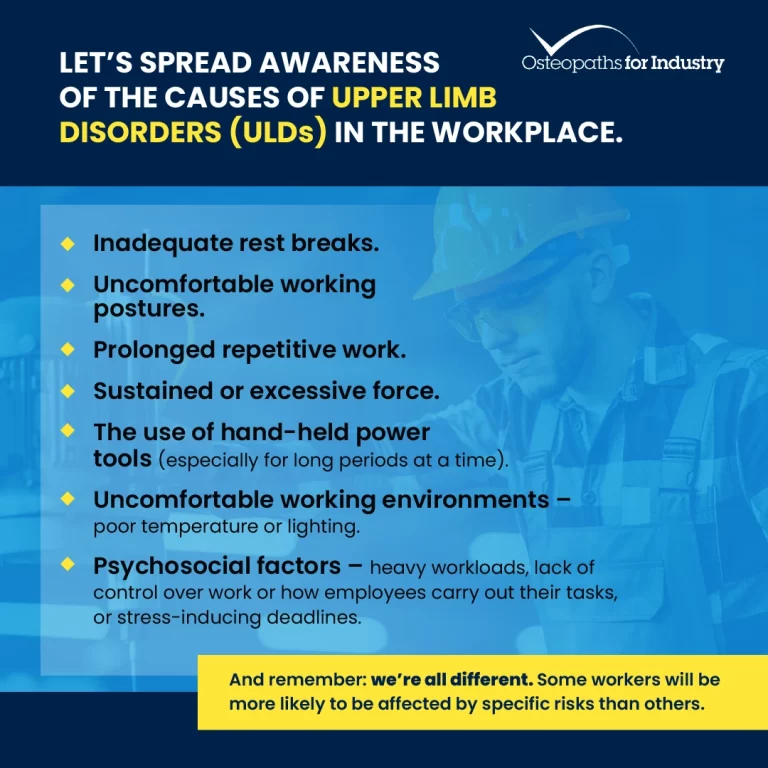As an employer, protecting your employees’ musculoskeletal health is critical to ensuring a safe and productive working environment. Upper limb disorders (ULDs) pose a significant risk to workers, causing discomfort and affecting their overall wellbeing inside and outside work. In this blog post, we will explore the causes of ULDs, highlighting the importance of risk assessment and providing you with practical strategies to prevent and mitigate the risk these disorders pose to your workforce. By implementing effective measures to protect against ULDs, you can safeguard your employees’ musculoskeletal health, increasing their productivity levels and promoting a culture of workplace safety.
DID YOU KNOW?
In 2020/2021, ULDs accounted for 45% of all work-related musculoskeletal disorders (both new and long-term), whilst back and lower limb-related MSDs accounted for significantly less, at 39% and 16%, respectively. This underlines just how important it is for us to take proactive steps to protect our employees’ musculoskeletal well-being against ULDs.₁
What Do We Mean When We Talk about Upper Limb Disorders (ULDs)?
ULDs can manifest in various symptoms that affect the shoulders, arms, wrists, hands, fingers, and neck. These include:
- Aches and pains
- Tenderness
- Numbness or tingling
- Weakness
- Cramp
- Burnin
- Redness
- Swelling
- General discomfort
Who’s at Risk?
Common industries at risk include assembly lines, construction, meat or poultry processing, and work involving long hours spent on a computer or laptop. Recognising and addressing the factors that can cause or contribute towards the development of ULDs is vital for protecting your workers and maintaining their wellbeing.
The Importance of Communication:
You must encourage your employees to report any symptoms of ULDs or other musculoskeletal discomfort as soon as they first notice the signs. Early detection allows you to take appropriate action to support the affected employee and reduce the risk level for other workers. The sooner a problem is recognised and reported, the sooner it can be treated, preventing lost productivity and deterioration of employee wellbeing.
Examples of ULDs:
- Carpal Tunnel Syndrome (CTS) ₂ – characterised by aching, pain, tingling, numbness, weakness, or difficulty gripping; CTS occurs as a result of pressure exerted on a nerve in your wrist. It can be caused by activities requiring you to frequently grip hard or bend your wrist, e.g., when using vibrating tools at work or when playing a musical instrument.
- Osteoarthritis ₃ – characterised by stiff, aching joints that may be accompanied by tenderness, swelling, or a crackling sound when moving. Work-related activities can exacerbate the discomfort associated with osteoarthritis.
- Hand-Arm Vibration Syndrome ₄ – is caused by long-term use of powered hand tools and can cause permanent disorders of the joints, nerves, or blood vessels, causing pain and discomfort. Research shows that in the UK, around 2 million people are at risk of developing HAVS.
- Tendonitis ₅ or Tenosynovitis ₆ – Tendonitis occurs when a tendon swells and becomes irritated as a result of an injury, whilst tenosynovitis develops when the sheath of tissue that encircles a tendon becomes inflamed. Both are similar conditions that can inhibit the affected joint’s movement and cause pain or stiffness. These conditions are commonly caused by unsafe musculoskeletal working practices, including poor posture or technique.
Immediate Action
If an employee is carrying out a task that’s causing or exacerbating a ULD, you should arrange for them to stop doing that task for a while to let their pain levels improve.
DID YOU KNOW?
Upper limb disorders can be caused or worsened by:
- Prolonged repetitive work.
- Uncomfortable working postures.
- Sustained or excessive force.
- Inadequate rest breaks.
- The use of hand-held power tools (especially for long periods at a time).
- Uncomfortable working environment – e.g., poor temperature or lighting.
- Psychosocial factors – e.g., heavy workloads, lack of control over work or how employees carry out their tasks, or highly pressured, tight deadlines that cause stress or anxiety.

Remember: we’re all different. Some workers will be more likely to be affected by specific risks than others.
Conducting a Risk Assessment:
Conducting a comprehensive risk assessment is essential to effectively manage the risk of ULDs in your workplace. Here are the key steps you should consider:
- Identify Potential Hazards: Look for tasks that may cause harm to your employees’ upper limbs and determine the factors contributing to the risk.
- Assess Likelihood of Harm: Evaluate the likelihood of workers being harmed and prioritise areas that require immediate attention.
- Control Measures: Implement control measures to eliminate or reduce the risk. Involve workers in the process, as they can provide valuable insights and suggest solutions.
- Detailed Assessment: If the initial risk assessment indicates a need for further evaluation, consider using tools such as the HSE’s Assessment of Repetitive Tasks tool (ART) or HSE’s ULDs risk assessment worksheets to analyse risk factors in more detail. These can help you by using colour coding and a scoring system to identify key action points.
At OFI, we excel in providing comprehensive, in-depth MSD risk assessments – it’s what we do best.
For over 35 years, we’ve been helping clients up and down the country protect their employees against MSDs and other workplace risks. Whether you’re looking for someone to conduct risk assessments for you or train your in-house risk assessors, we have the solution for you. Our experts specialise in:
Preventing Upper Limb Disorders:
While it may not be possible to prevent all cases of ULDs, there are practical steps you can take to minimise your employees’ risk level. Consider the following strategies:
Monitoring and Review:
Establishing preventive measures requires ongoing commitment, not just a one-time initiative. It is imperative to consistently monitor and review these measures to guarantee their effectiveness. Before implementing changes across the entire company, conduct small-scale tests involving a limited number of employees. Additionally, maintain open communication with workers, regularly seek feedback, and promptly address any emerging issues. This continuous and thorough approach is vital for maintaining a robust preventive framework.
- Design and Planning: When designing new workstations or tasks, anticipate and plan for potential risks. Eliminate or automate tasks where possible to reduce the strain on workers. It’s easier to design a workstation or plan new tasks with reducing the risk level in mind than it is to change them at a later date, only once they’ve started to cause problems.
If eliminating the risk isn’t possible, you should:
- Prioritise: Focus on reducing the risk level of activities that affect the most employees or are higher-risk tasks – these are your most urgent action areas.
- Take Ergonomics into Account: Ensure that tools and equipment are suitable for the task and properly fit workers’ hands. For a comfortable DSE set-up, provide adjustable workstations, suitable chairs, and footrests to promote supportive working postures.
- Focus on Posture and Force: Optimise workstation layouts to improve workers’ posture, particularly when applying force. Limit the amount of repetition, vibration, force, and prolonged fixed postures in tasks.
- Incorporate Rest Breaks and Task Rotation into the Working Day: Encourage regular changes in posture and provide suitable rest breaks to minimise the duration of repetitive tasks. Task rotation can help distribute physical demands and reduce strain on specific muscle groups.
- Improve the Working Environment: Create a comfortable working environment by addressing factors such as temperature, lighting, and draughts, as these can contribute to discomfort and exacerbate ULDs.
The Bottom Line on Limb Disorders
By prioritising the prevention of upper limb disorders in the workplace, employers can protect their employees’ musculoskeletal health and promote a safer working environment. Conducting thorough risk assessments, implementing ergonomic measures, and cultivating a culture of open communication are essential steps toward achieving these goals. Remember, the responsibility lies with employers to ensure the well-being of their workforce, and by investing in proactive measures, you can create a healthier and more productive workplace for all.
Safeguarding your employees’ musculoskeletal health is not only a legal obligation but also a strategic investment in the success of your organisation. Prioritise workplace safety and protect your most valuable asset—your workforce.
References
References:
1. Upper Limb Disorders, Health and Safety Executive (HSE), www.hse.gov.uk/msd/uld/index.htm.
2. “Managing Upper Limb Disorders in the Workplace: A Brief Guide”, Health and Safety Executive (HSE), www.hse.gov.uk/pubns/indg171.pdf.
3. “Upper Limb Disorders: Occupational Aspects of Management 2009”, Royal College of Physicians, NHS: Health at Work Network, www.rcplondon.ac.uk/guidelines-policy/upper-limb-disorders-occupational-aspects-management-2009.
4. “Work-Related Musculoskeletal Disorders in Great Britain, 2021”, Health and Safety Executive (HSE), www.lancashire.gov.uk/media/929659/msd_labour-force-survey_2021.pdf.
5. Carpal Tunnel Syndrome, NHS, www.nhs.uk/conditions/carpal-tunnel-syndrome/
6. Osteoarthritis, NHS, www.nhs.uk/conditions/osteoarthritis/
7. “Hand-Arm Vibration at Work”, Health and Safety Executive (HSE), www.hse.gov.uk/vibration/hav/index.htm
8. “Tendonitis”, NHS, www.nhs.uk/conditions/tendonitis/
9. “Tenosynovitis”, NHS, www.mkuh.nhs.uk/patient-information-leaflet/tenosynovitis#:~:text=Tenosynovitis%20is%20inflammation%20of%20the,wrist%2C%20ankle%2C%20or%20shoulder.
10. “Manual Handling Training”, Osteopaths For Industry, www.ofi.co.uk/manual-handling-training/
11. “People Moving & Handling”, Osteopaths For Industry, www.ofi.co.uk/people-moving-handling-training/ 12. “Display Screen Equipment”, Osteopaths For Industry, www.ofi.co.uk/display-screen-equipment/
13. “Ergonomic Training & Ergonomic Assessments”, Osteopaths For Industry, www.ofi.co.uk/ergonomic-training-assessment/








